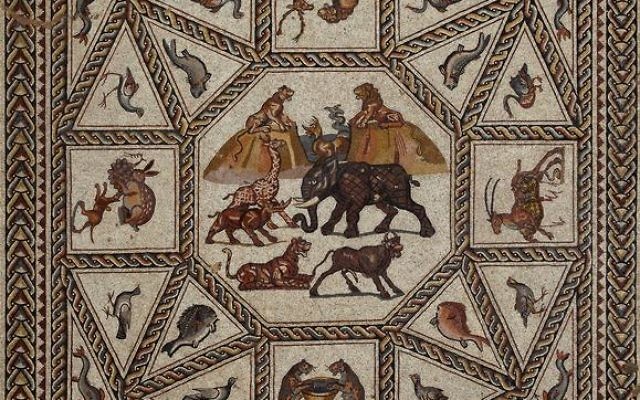Lod Mosaic in Miami Until May 29
People visiting Miami this month have a chance to see one of Israel’s best-preserved artifacts, the Lod Mosaic, on its final stop of a U.S. tour.
The Roman mosaic dates to the third century C.E. and was saved by the Israel Antiquities Authority after it was discovered by a highway construction crew in 1996. The mosaic is believed to have been the floor of an audience room in a grand villa owned by a wealthy merchant. Because the mosaic has no religious content, archaeologists can’t be sure whether the owner was Jewish, Christian or pagan.

The central medallion of the Lod Mosaic features an array of exotic animals.
The mosaic is being shown through Sunday, May 29, at the Patricia & Phillip Frost Art Museum, on the campus of Florida International University, in an exhibit called “Predators & Prey,” a reference to exotic menagerie depicted in the artwork. Admission to the museum is free.
The Lod Mosaic is one of the most viewed Israeli touring exhibitions. When the Israel Antiquities Authority first opened the mosaic to the Israeli public for only one weekend, more than 30,000 people traveled to Lod to see it.
“We are absolutely delighted and honored to have been afforded this once-in-a-lifetime opportunity to exhibit a significant work from Roman antiquity,” said Jordana Pomeroy, the Frost Museum’s director. “The Lod Mosaic’s excellent state of preservation and the IAA’s superior conservation allow us to appreciate how the finest mosaic work can bring alive the ancient world.”
Lod stands on the site of the ancient city of Lydda, which developed on an important trade route from Egypt to Syria and Mesopotamia. The city was destroyed in 66 C.E. during the Great Jewish Revolt and was rebuilt as Diospolis, the “city of Zeus.” Around 200 C.E., Emperor Septimius Severus made it a Roman colony.
Archaeologists have calculated that more than 2 million tiles were used to create the mosaic. Three central panels were chosen from the excavation for the traveling exhibition: two rectangular end panels flanking a large square central medallion. Indigenous animals coexist with ferocious wild creatures such as lions, tigers, an elephant, a giraffe, Asian water buffalo and a sea monster.
After Miami, the mosaic will return to Lod, where its permanent home, the Shelby White and Leon Levy Lod Mosaic Center, is under construction.




comments